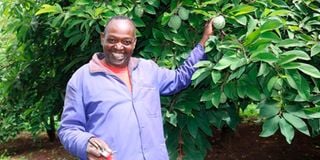Former truck driver savours juicy custard apple returns

Fredrick Kinyanjui, a former truck driver grows custard apples on half an acre in Nyati village, Kamahuha, Murang’a County.
The green shiny fruits on Fredrick Kinyanjui’s farm in Nyati village, Murang’a County, look like apples from far, but on closer scrutiny, one spots the difference.
While apples usually have a smooth skin, these ones are scaly and cone-shaped. “They are custard apples (Annona reticulata). They are also known as sugar apple,” says Kinyanjui, adding that in Kiswahili, they are called matomoko.
He learnt the art of growing fruits from his father, who had been in the business since 1970s.
“I started growing a variety of fruits in 1995. I have 39 custard apple trees that sit on half-acre of my five. I love fruits because I also grow avocados, bananas and mangoes, however, custard apples are my favourites,” he says.
The former truck driver does not regret quitting his job after 22 years in the industry since fruits have offered him steady income.
He plants grafted varieties. “I use indigenous root stock that I graft with the improved varieties. Traditional custard apple seeds have a germination rate of about 99 per cent, while the hybrid below 10 per cent,” explains Kinyanjui.
Custard apples
The farmer extracts seeds from well-ripe custard apples, washes and dries them for two days. He then plants them in polythene bags and raises the seedlings for 10 months to one year.
Thereafter, he grafts them with scions sourced from his farm. “After transplanting, the seeds must be nurtured well with manure, fertiliser and water,” Kinyanjui says, adding that under good agricultural practices, they start fruiting after six years.
His custard apple trees flower in October, noting that during the period, they must be watered well to curb flower abortion that affects fruit formation.
“Flowering is preceded by shedding of leaves in September but once irrigated properly or they receive good rains, the onset of flowering and fruit formation starts,” he explains.
Shedding of leaves, according to Geoffrey Kavita, an agronomist from Amiran Kenya, is a common characteristic of fruit crops.
“It is a natural way to stimulate the emergence of buds,” he states.
There is a correlation between shooting of buds and flowers, Kavita explains, in case natural mechanisms fail, synthetic ways can be used, like using bio-stimulant products, sprayed to expedite the process.
Kinyanjui, 57, says apart from planting and watering, one should apply manure to replace lost nutrients, prune the crop and spray against diseases like powdery mildew and anthracnose.
For pests, the biggest enemy of the fruits are fruit flies and false codling moth (FCM), with the farmer using pheromone traps to curb them.
Peak harvesting comes between April and August. But according to Kinyanjui, he also reaps during off season in October.
A tree produces up to 700 kilos per year. Kinyanjui sells the fruits at between Sh50 and Sh80 to clients in Nairobi, one of them which is a supermarket.
Annual rainfall
Lack of reliable workers is one of his major challenge, noting that he relies on women to take care of the fruits as getting young men is a problem.
Custard apples thrive in regions that receive more than 700 millimetres of annual rainfall.
The altitude required depends on the variety of the fruit; cherimoya 1,400–2,200m above sea level, sweetsop also known as Annona squamosa 0–1,100 while soursop 1,400m. He farms annona and soursop varieties.
The fruit, according to Kavita, performs well when grown in soils which are slightly acidic and well-drained.
Kinyanjui grows Hass avocados on one-and-half acres, mangoes four and plantain bananas in between custard apple trees.
Custard apples are rich in antioxidants, boost immunity, promote good digestion and regulate blood pressure. They are consumed when ripe, where the sweet flesh is extracted. They can also be used to make juice and jam. A ripe custard apple is pale green.





